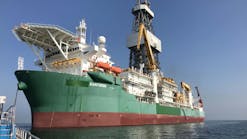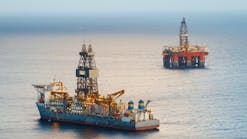If the breadth and depth of new technology for measurement-while-drilling (MWD) and logging-while-drilling (LWD) tools is any indication, the downturn in the industry may be short lived. The editors ofOffshore magazine have scoured the globe for the latest and greatest technologies for 2009, and here is the result. The following pages also update the annual MWD/LWD services directory. The full survey is available for download at www.offshore-mag.com.
Baker Hughes INTEQ
INTEQ says its tools are highly modular to facilitate optimal sensor placement within the bottomhole assembly (BHA) for each Answers While Drilling application.
New services include:
- aXcelerate high-speed telemetry, which enables both the industry’s fastest mud-pulse telemetry system and, in conjunction with The IntelliServ Network, the most widely deployed wired-pipe telemetry system. Delivering fast, high-resolution, real-time MWD and LWD data, aXcelerate enables answers to optimize drilling and maximize ROP, accurately position the wellbore for maximized production, minimize NPT by constantly monitoring wellbore integrity, and continuously manage pressure for maximized safety
- The temperature range for the AutoTrak rotary steerable service, including the OnTrak integrated MWD/LWD tool, has been expanded up to 175° C (347° F) for 8 ½-in. and bigger holes
- The AziTrak Deep Azimuthal Resistivity service, a fully integrated MWD/LWD tool that is compatible with INTEQ’s AutoTrak rotary steerable service, now is also available for 5 7/8-in.– 6 ¾-in. hole sizes. AziTrak provides directional, azimuthal gamma imaging, multiple propagation resistivity (MPR), deep azimuthal propagation resistivity imaging, temperature, annular pressure, and vibration stick-slip measurements from a single sub. The deep azimuthal propagation resistivity measurement delivers an image for the real-time detection of approaching boundaries at any azimuthal angle. The image provides easy-to-read information to the operator to navigate the wellpath into and through the reservoir
- MagTrak Advanced Magnetic Resonance While Drilling is now also available for the 5 7/8-in. – 6 ¾-in. hole size. The service delivers matrix independent porosity data including total and partial porosities, permeability index, light hydrocarbon saturation, and real time T2 distribution data
- The ZoneTrak bit resistivity service provides a resistivity reading within a short distance of the bit for the earliest possible detection of formation change, fault zone, casing/coring point, and reservoir entry detection. It works well in both water based and oil or pseudo-oil based drilling fluids.
Halliburton/Sperry Drilling
In 2009, Sperry Drilling introduces the world’s first LWD formation fluid identification and sampling tool. The GeoTap IDS helps reduce reservoir uncertainty even in complex environments thanks to timely downhole identification, capture, and surface recovery of multiple samples of uncontaminated, formation fluids.
In 2009, Sperry Drilling also focuses on solutions for optimal wellbore placement and maximum production. One such solution is an integrated geosteering service that uses StrataSteer 3D software and the InSite ADR azimuthal deep resistivity sensor. The InSite ADR sensor can map the formation response 360° around the borehole and 18 ft (5 m) into the formation. The sensor data are fed into the StrataSteer 3D geosteering software program. Using this information, Halliburton specialists advise asset teams, in real time, how to optimize the well path to hit all targets.
For reservoir imaging, the InSite AFR sensor provides sharp borehole images while drilling, Halliburton says. It may replace wireline imaging tools in horizontal sections, where running pipe-conveyed wireline logging tools is too risky. It also provides high quality data since the information is acquired while drilling when less filtrate invasion and borehole degradation have occurred.
To allow for high-speed data transmission, Halliburton is enhancing its electromagnetic (EM) telemetry system. Unlike mud-pulse systems, an EM system can transmit data without a continuous fluid column; making EM telemetry suited for not only over-balanced drilling, but also under-balanced applications. EM telemetry also provides greater reliability and transmission speed than traditional mud pulse systems.
Weatherford
Designed on the industry’s newest while-drilling formation evaluation and well placement platform, Weatherford’s MWD, LWD, and rotary-steerable systems work in all drilling environments, from routine to the most extreme, and often replace legacy systems to complete projects they cannot. In addition to withstanding extreme pressures and temperatures, these systems offer short-radius and high-dogleg running ability to negotiate complex well paths, access previously unreachable reserves, and steer clear of problem zones.
The most recent addition to Weatherford’s while-drilling suite is the Weatherford LWD ShockWave sonic tool for sonic logs while drilling. The tool is designed around a high-output transmitter and unique attenuator and is supported by advanced acquisition modes and real-time processing techniques to provide accurate, reliable data in downhole pressures as high as 30,000 psi (207 MPa) and temperatures of up to 329° F (165° C). The resulting logs enable well teams to calibrate seismic data reliably and to correlate time to depth, determine pore pressure, and evaluate porosity while drilling, even in soft formations and noisy environments. Porosity evaluation can be obtained in large boreholes and behind bi-center bits.
Weatherford says its new ABM at-bit-measurement system uses scintillation technology to provide the industry’s only below-the-motor azimuthal gamma ray measurement with real-time imaging for more reliable wellbore placement during geosteering and more accurate wellbore separation in SAGD wells. The combination of inclination and gamma ray at the bit results in fewer sidetracks and increased hydrocarbon recovery. Overall well ROP is increased by spending less time sliding. Lithium battery power ensures uninterrupted operation, even when mud is not flowing through the BHA. Rig time is saved by storing information in non-volatile memory, which ensures reliable data retrieval, either from the EDP port on the sensor or via the MWD system memory.
The Revolution Plus motorized rotary-steerable system delivers wellbore placement and drilling performance in complex and extended-reach wellbores without sacrificing reliability or run life. The system is available in either wired or wireless configurations, both of which place a Weatherford high-performance, mud-lubricated directional drilling power section between the rotary-steerable tool and the LWD sensors to deliver higher ROP while reducing surface RPM. The wired-motor option uses a HyperLine Plus high-torque, high-performance power section with even-rubber-thickness (ERT) technology. The wireless option uses Weatherford’s DualPulser wireless telemetry service with any Weatherford directional drilling motor power section. Two independent, dedicated telemetry systems create redundant, parallel channels of data transmission that effectively can double bits-per-second (BPS) data rate to improve data transfer for drilling optimization and geosteering. The DualPulser wireless system is easy to configure and places no limitations on power section or bit, so well teams can select the best motor and bit for the formation and can also change power sections as needed.
Additional Weatherford MWD, LWD and well placement technologies include the following.
- HyperPulse MWD system, a conventional mud-pulse MWD system capable of operating in mud environments of up to 80 lb/bbl
- EMPulse EM MWD system, which has been used to drill more wells worldwide than any other electronic MWD system and which is a key enabler of underbalanced directional drilling
- HEL hostile-environment logging MWD system, which Weatherford says has the industry’s highest ratings for temperature and pressure and delivers wireline-quality data at drilling rates of up to 400 ft (122 m) per hour
- Weatherford LWD system, with a full array of the industry’s most robust sensors.
Click here to download the pdf of the "2009 MWD/LWD Services Directory"
Notes for the survey
PathFinder:
(a) HDSM, CWRG, DNSC, CLSS, DPM, DFT, AWR tools are data-linked and may be configured in any order
(b) 2DRS is a stand-alone tool or run with any M/LWD system
(c) PathMaker is a stand-alone tool or run with any M/LWD system.
Unidrill Energy Co. Ltd.:
(d) Sentinel Shock and Vibration Measurement available for all Orienteer and Liberator tools
(e) TRIM resistivity
(f) 4 3⁄4, 6 3⁄4, 8, and 9 1⁄2 in. Orienteer strings retrievable only when run with positive pulse transmission system. Negative pulse system non-retrievable
(g) Pressure drop over +ve pulse Orienteer tools same as Liberator
(h) Provisional
(i) Orienteer steering tool option for 4 3/4, 6 3/4, 8, and 9 1/2 in. tools
(j) Higher temperature rating available on request.
Baker Hughes INTEQ:
(k) Dependent on mud weight, hydraulics, data transmission, and turbine
selection(l) All directional accuracies are to 2 Sigma confidence
(m) All tool combinations require a directional tool (D, OnTrak, or NaviTrak) as a basic component ex. D+LithoTrak+MPR = 69.4
(n) All generic and environment specifications are Included in the directional category
(o) Basic AutoTrak configuration consists of near bit inclination + gamma ray + multiple propagation resistivity + vibration + directional sensor + modular connection
(p) Basic Navigator configuration consists of near bit inclination + gamma ray + multiple propagation resistivity + modular connection
(q) Static and Dynamic WOB, TOB, bending moment, annular and bore pressure, string RPM, lateral and axial acceleration. Also includes motor RPM and downhole drilling dysfunction diagnostics
(r) Commercially available in 4 ¾ in. and 6 ¾ in. tool size.
(s) Requires interface sub to IntelliServ network (commercially available in 4 ¾ in., 6 ¾ in., and 8 ¼ in. tool size).
(t) Max DLS values are a function of various parameters such as BHA configuration, well profile, hole size, drilling mode (build, drop, and turn). For optimum tool capabilities and limits, expert company advise is required (BHASYSPro analysis) therefore contact your local BHI representative for a DLS calculation based on your specific BHA.
Schlumberger:
(u) Accelerometers for vibration and inclination at bit, strain gages for weight and torque, transducer for annular pressure
(v) Down hole neutron and gamma ray sources are wireline retrievable
(*) Variable transmission rates available as an option with Telemetry Systems
(*) Pressure drops are dependent on mud weight and tool configurations
(*) Rotating & Sliding Max DLS limitations listed are for infinite connection life
(*) Real-time update periods are variable depending on tool string configurations.
Halliburton/ Sperry Drilling Services:
(w) The attributes of the pulser sub, negative or positive, and the central interface module sub are not included in any of the data listed for the individual measurement subs
(x) Length for EMT directional tool includes associated subs required for service
(y) Values for EBS are for standard collars; flexed collars are also used and their values are higher for the same nominal tool OD
(z) Special tool designs are rated for higher operating temperatures and pressures (HT: up to 175˚C [347˚F] and HP up to 30,000 psi)
(aa) When using the negative pulsing system, there is no flow rate range; however, a maximum, tolerable mass flow rate is dictated by erosion concerns, and this limit varies by tool size and design
(bb) The pressure drop stated for 8-in. tools is for those having a 1.92-in. ID. Some 8-in. tools have an optional larger ID (called 8-in. HF), which will reduce the pressure drop stated and also increase the maximum, tolerable mass flow rate
(cc) The pressure drop across the negative pulsing valve is the parameter of concern. This parameter is a function of the mudflow rate, the BHA, and the mud properties.






